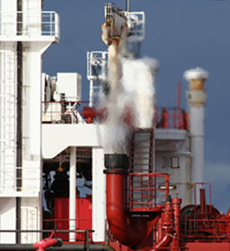

VOC release during |
Basic introduction to VOC and the CVOC® system |
|
What is VOC? Volatile Organic Compounds (VOCs) are organic chemical compounds that have high enough vapor pressure under normal conditions to significantly vaporize and enter the atmosphere. The term VOC has a very wide definition, and includes both natural and synthetic substances. In this context the term VOC is used to describe light-end components found in crude oil and refined petroleum products. Examples of such VOCs are Methane, Ethane, Propane, Butane and Pentane. These substances are, as the name suggests highly volatile, and will evaporate from the liquid at ambient pressure and temperature. A very good example is the fumes you see and smell when filling petrol on a car. The same effect takes place on a crude oil tanker, except on a much larger scale. What's the problem? Tankers, floating storage vessels, and to a certain extent also storage tanks in tank farms, are normally closed containers. Basic thermo-dynamics tells us that natural evaporation of VOCs from the liquid stored in such closed containers will result in a pressure increase until equilibrium between gas and liquid is reached. The evaporation of VOCs is further amplified when the tanks are filled with inert gas prior to loading. This happens because the inert gas does not contain any VOCs. The liquid will increase the evaporation in order to saturate the tank atmosphere with VOCs, and thus obtaining an equilibrium between gas and liquid. The pressure increase is caused by the simple thermo-dynamic fact that gas requires a larger volume than liquid at a given pressure & temperature. Unfortunately the equilibrium pressure between crude oil (or other liquid petroleum products) and VOCs is higher than the design pressure of “storage containers”, i.e. tankers, FSOs and on-shore storage tanks. This means that the pressure normally have to be released when the vapor pressure exceeds the storage container’s design pressure. On a tanker this will normally be done through the mast riser or PV valves. How is the CVOC® system helping? The CVOC® system reduces tank pressure without releasing anything to the atmosphere by absorbing VOCs back into the liquid it first came from (turning gas into liquid). Since liquid requires less space than gas, the tank pressure will be reduced. Tank pressure is continuously monitored by the CVOC® system, thus when the pressure is sufficiently reduced the CVOC® system stops automatically. Likewise, when the pressure reaches a pre-set level the CVOC® system will start automatically to reduce tank pressure. For further information on the CVOC® system reference is made to our Products section. |
Org. No.: 986 490 000 MVA